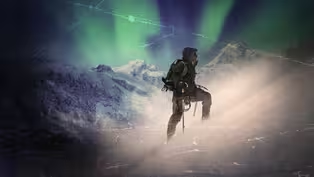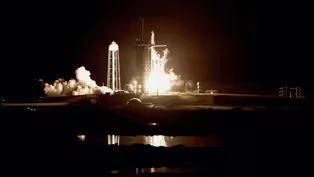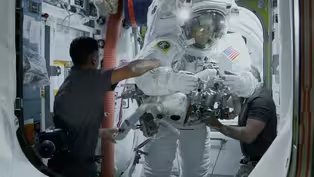
What an Antarctic Disaster Can Teach Us About Getting to Mars
Clip: Season 25 Episode 16 | 15m 9sVideo has Closed Captions
How do you keep humans sane and relatively content in isolation?
A manned mission to Mars presents a huge array of challenges for scientists and explorers to figure out. Chief among them: how to keep humans sane and relatively content on the isolating, confining, and potentially years long journey to the red planet and back. Turns out, explorers from generations ago here on Earth survived similar challenges that tomorrow's astronauts can learn from.
Problems playing video? | Closed Captioning Feedback
Problems playing video? | Closed Captioning Feedback

What an Antarctic Disaster Can Teach Us About Getting to Mars
Clip: Season 25 Episode 16 | 15m 9sVideo has Closed Captions
A manned mission to Mars presents a huge array of challenges for scientists and explorers to figure out. Chief among them: how to keep humans sane and relatively content on the isolating, confining, and potentially years long journey to the red planet and back. Turns out, explorers from generations ago here on Earth survived similar challenges that tomorrow's astronauts can learn from.
Problems playing video? | Closed Captioning Feedback
How to Watch Independent Lens
Independent Lens is available to stream on pbs.org and the free PBS App, available on iPhone, Apple TV, Android TV, Android smartphones, Amazon Fire TV, Amazon Fire Tablet, Roku, Samsung Smart TV, and Vizio.
Buy Now

The Misunderstood Pain Behind Addiction
An interview with filmmaker Joanna Rudnick about making the animated short PBS documentary 'Brother' about her brother and his journey with addiction.Providing Support for PBS.org
Learn Moreabout PBS online sponsorship(harrowing music) (wind whistling) - Men wanted for hazardous journey, safe return doubtful, honor and recognition in case of success, - [Narrator] Legend has that Sir Ernest Shackleton placed this ad in "The London Times" in December of 1913 to recruit for his Antarctic expedition.
While the text of the ad most likely never actually appeared in the newspaper, these words paint a true picture of what this expedition would entail.
They never reached Antarctica.
Their ship became perilously stuck in ice at the end of the world, slowly being crushed in the darkness, stranded and completely isolated from the rest of humanity in the harshest conditions on the planet.
What kept the crew from succumbing to madness?
Now, is this a fascinating historical mystery?
Sure.
But more than a century later, historians, scientists, and a new era of explorers are realizing this failed expedition also holds key lessons for our future: how astronauts might survive on a journey to Mars.
(subdued music) Shackleton and his 27-man crew set sail aboard the Endurance in 1914 with the goal of becoming the first expedition to cross Antarctica on foot.
But after departing from a whaling station in South Georgia in December, the crew would end up having no contact with the outside world for nearly 500 days.
Less than a month later, with Antarctica visible on the horizon, the Endurance became trapped in sea ice.
It didn't take long for Shackleton to realize that a hope for escape wouldn't come for months.
They had no way of communicating with anyone beyond the ship for help, but Shackleton knew that if they were to have any hope of survival, he had to convince his crew that rescue was possible.
From the start, Shackleton made sure the crew stayed busy with teamwork.
They occupied their time with things like soccer and hockey on the ice, building igloos and even dogloos for their sled dogs and training the dogs for the still-planned trek across Antarctica.
In these early days, spirits and hope remain high, but Shackleton knew the Endurance was slowly being crushed by the force of the ice.
He began to prepare for the inevitable, stowing supplies in the three lifeboats they had aboard.
And in October, 10 months after setting sail, the ship began to take on water, and that's when Shackleton made a fateful declaration to his crew.
"Ship and stores have gone, so now we'll go home."
The mission to cross Antarctica was officially over.
He'd given them a new mission: to get back home safely.
The men salvaged as much as they could before the ship was lost to the ice, including the three lifeboats, food, clothing, tents, everything they would need to start a long trek across the sea ice toward potential escape.
They also grabbed things that might not seem like necessities for survival at first: a bunch of books and a banjo.
Shackleton knew if there was any hope to keep his crew alive and sane while isolated from the world, he needed to keep them focused on the ultimate goal of getting home.
Psychological effects had been documented by previous polar explorers like hallucinogenic fugue states and a nervous irritability dubbed "expedition madness."
Shackleton kept a careful eye on the morale of his crew.
To keep their spirits up, they celebrated holidays, put on plays, sang and wrote songs, journaled, read a lot of books, and exercised frequently.
If the conditions of the day were particularly depressing, he'd tell the expedition cook to make an extravagant meal.
Well, as extravagant as you could get when your diet is seal, penguin, and dwindling rations from the ship like tinned herring and fish paste.
But how long could they survive isolated at the end of the world?
Surprisingly, an Antarctic expedition that happened over a century ago can teach us a lot about the isolation astronauts will face on the two-year round-trip journey to Mars.
Cultural anthropologist, Dr. Jack Stuster, points out that while spaceships may be much more technically complex than sailing ships, they are similar psychological environments, with crews that are isolated from the rest of humanity for extended periods of time.
Isolation.
The experience of being physically and psychologically cut off from humanity is one of a handful of colossal challenges faced by explorers.
For decades, Antarctic expeditions have been used as both environmental and psychological analogs for researchers interested in how the isolation of space travel will affect the human mind.
But a mission to Mars would be even more isolated than most Antarctic expeditions.
Shackleton had a crew of 27, while early missions to the red planet would likely have just six to eight crew members.
This is Dr. Nina Lanza.
She's a planetary scientist who specializes in Mars.
And she also worked in Antarctica as part of a program called the Antarctic Search for Meteorites.
Pairs of scientists are sent to live in tents out on the vast ice sheet for six weeks at a time.
They have no creature comforts and almost no contact with the outside world.
- One of the things about going to Antarctica is that it's really, really isolated, like more isolated than any other place on earth.
And because of that, it's a really good place to train for long-duration space flight missions because you're kind of in a spaceship, in your little tent, and you need to spend a lot of time inside in very cramped quarters with people that you might not have known very well before you started your mission.
- Psychological effects of extreme isolation have been documented in both real and simulated space missions as well as during modern polar expeditions.
And these symptoms include depression, hostility, trouble sleeping, and issues with memory, attention, and cognition.
And these could cause problems, not only for the crew members suffering those symptoms, but for the entire expedition.
- One of the things that surprised me the most about doing this work in Antarctica was how much the isolation really affected me.
I knew I would be away from my family, but I didn't realize how disconnected I would be from my regular reality.
So it's incredibly discombobulating and it really felt like I was on another planet.
- You might think one solution to the loneliness would be for the crew members to talk to their friends and families back home more often to stay connected with the outside world.
Astronauts in the International Space Station often look forward to their video calls with family members back home.
In some cases, however, research has shown that too much connection with the outside world can be harmful rather than helpful.
In Antarctica, distractions around communications from home have led to accidents and even sending crew members home.
During NASA's Human Exploration Research Analog missions, most of the crew members stopped reading the news from Earth despite being offered daily newspapers because they wanted to escape the real world.
It was a distraction from the mission.
Admiral Richard Byrd, who spent eight months alone in a 9x13-foot hut near the South Pole in 1934 even noted that getting news updates from the outside world via radio caused him anxiety rather than relief.
Saying "The few world news items which were read to me seemed almost as meaningless as they might to a Martian."
There's a delicate balance to strike: maintaining important connections with friends and family while also keeping focus on the expedition at hand.
- We really have to work together because our lives truly depend on it, and so that's really important that we let things go.
You know, sometimes people irritate you, especially if you're living in an eight foot by eight foot tent with them, you know, but we have to find a way to make it work or else we cannot get our mission done and we might actually hurt ourselves.
- Many of us experienced the psychological challenges of isolation during the COVID-19 pandemic, but space and polar explorers face a form of isolation that few humans ever will.
Isolation even leads to physical changes in our brains.
A group of German researchers took MRIs of the brains of an Antarctic crew before and after a 14-month-long mission.
They found that portions of their hippocampus shrunk in volume.
This is the part of the brain responsible for regulating things like memory, learning, motivation, and emotion.
The researchers attributed these changes to a combination of the monotony of their daily tasks and environment, social and physical isolation, and stress.
These are all conditions that astronauts would face on a journey to Mars as well.
There are two big unique concerns, however, for crews traveling to Mars the terrestrial explorers don't encounter.
The first is delayed communication.
Even at the speed of light, signals from Earth take anywhere between 4 and 40 minutes to reach Mars.
This means that at some point along the journey to the red planet, astronauts will no longer be able to communicate with anyone outside of their ship in real time.
Living in a world today where we are constantly connected, this will be a huge psychological shift.
Mars analog missions here on Earth, like Hi-SEAS, simulate this time delay when talking to anyone outside of their habitat.
But mentally, it's probably not quite the same as knowing you are truly, completely, cut off from the rest of humanity.
And these analog missions can't simulate the second big concern: the Earth-out-of-view phenomenon.
It's the point in the journey to Mars where Earth becomes a nearly indistinguishable blip of light against the background stars.
Psychologists think this may lead to deep feelings of isolation and loneliness.
Humans have never been that far from our home planet before.
This might all sound pretty bad, but there's something called the paradox of solitude.
Isolation has both negative and positive effects.
Spending time alone with your thoughts can reduce stress and give space for self-exploration, a feeling of connectedness with yourself and the universe.
You might have experienced some of this yourself if you've ever tried meditation or gone camping in the wilderness.
And this sentiment is heavily reflected in the diaries of Antarctic explorers like Shackleton and Byrd, even memoirs of modern day astronauts.
- One of my favorite things that we did every single day that we were out in the fields is that we read from the journals of Scott, Amundsen, and Shackleton.
And it's incredible because a lot of the things that they were thinking and feeling were the same things that we were thinking and feeling.
It's very harsh in the Antarctic environment.
It can be really grinding.
Whenever I felt myself feeling very negative and being upset about little things, I always took a moment to focus on the horizon and to remind myself of where I was.
You know, Antarctica is an incredibly beautiful place and you know, just looking out and focusing outward and at a distance to realize I'm so privileged to be in this place.
And so that's what I tried to do to keep perspective.
Just to think about how fortunate I was.
- Shackleton's crew spent about 15 months stuck in Antarctica before they made it to a location where they could launch their lifeboats toward Elephant Island.
This was far from the end of their journey, however.
The island was uninhabited.
Shackleton decided to set forth in one of the lifeboats with five of his crew, hoping to make it back to the whaling station in South Georgia where they'd last had contact with the outside world.
It would take another four months before a rescue ship with Shackleton on board would make it through the sea ice back to Elephant Island.
And he arrived to find every single one of his crew alive.
Despite the dire situation faced by Shackleton's crew as they were stranded on the ice, he later wrote that the team, "adjusted with surprisingly little trouble to their new life, and most of them were quite sincerely happy."
Humans are remarkably resilient creatures when survival is on the line.
Their full ordeal lasted 22 months, on the order of a round trip journey to Mars.
While our technology for exploration may have changed a lot since the time of Shackleton, humans, at their core, haven't.
Thanks to Shackleton's experience, leadership, and keen observation of his crew, he was able to maintain their mental health as well as crew cohesion, comradery, despite their extreme isolation and the risks that held.
- He never made it to the South Pole, but in many ways what he accomplished was even more incredible because he was able to save every single person on his expedition, even though they lost everything, they literally lost their boat and they had to find their way back to civilization.
- They were a team working together for survival and the ultimate shared goal of getting home.
That same type of leadership and teamwork will be critical for humans to make the journey to Mars and stay happy and healthy in the process.
These days, we are really good at getting humans safely to and from Antarctica, and even to the International Space Station and back.
We know the technology we need to get to Mars and to keep humans alive on the way, but even with hundreds of years of exploration experience under our belts, it's still us, the human element, that isn't fully understood.
"Uncharted Expeditions" is a special series exploring the unique challenges facing human explorers as we set off in the next great era of discovery beyond Earth.
Make sure you subscribe to PBS Terra so that you don't miss a single episode.
And to learn more about the effects of isolation on astronauts in space, be sure to watch "Space: The Longest Goodbye" on the PBS app or just check the link down below.
Antarctica's Survival Guide for Mars Explorers
Video has Closed Captions
Clip: S25 Ep16 | 13m 41s | How did the extreme Antarctic winter affected the Belgica's crew? (13m 41s)
Can Humans Get to Mars Without Going Insane?
Video has Closed Captions
Clip: S25 Ep16 | 12m 32s | How can future astronauts best prepare themselves to face these challenges? (12m 32s)
Trailer | Space: The Longest Goodbye
Video has Closed Captions
Preview: S25 Ep16 | 30s | NASA psychologists prepare astronauts for the extreme isolation of a Mars mission. (30s)
Watch Space: The Longest Goodbye with PBS Passport
Video has Closed Captions
Preview: S25 Ep16 | 30s | Get early access with PBS Passport. (30s)
Extended Trailer | Space: The Longest Goodbye
Video has Closed Captions
Preview: S25 Ep16 | 1m | The grueling journey to Mars. (1m)
Providing Support for PBS.org
Learn Moreabout PBS online sponsorshipSupport for PBS provided by:




















